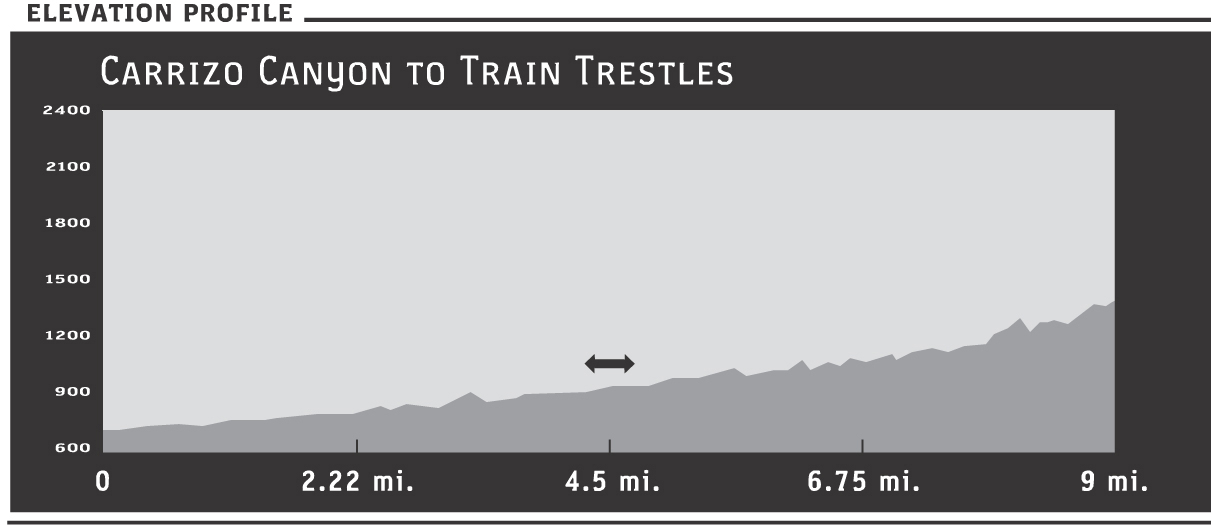30 Carrizo Canyon to Train Trestles
SCENERY: 
DIFFICULTY: 
TRAIL CONDITION: 
SOLITUDE: 
CHILDREN: 
DISTANCE: 4–18 miles round trip
HIKING TIME: 2–11 hours
OUTSTANDING FEATURES: Sandy wash, interesting rocks, seasonal stream, mortreros, wildlife, and train trestles
If you plan to hike the entire length from County Route S2, you may want to plan an overnight because of the length. But the relatively flat, easy-to-walk terrain makes this trek possible also as an all-day hike. Evidence of illegal immigrants passing through the last 2 miles outlined here may influence your decision about staying overnight—or in choosing a location to camp (probably somewhere in the first 7 miles, where vehicles are allowed). The wide canyon offers solitude, although on busy days you may see people in four-wheel drives before you reach the vehicle closure sign.
OPTIONS: A four-wheel drive can traverse the first 7 miles, delivering you to the vehicle closure sign, where you can go the last 2 miles on foot—but walking allows you to experience a close-up view of this quiet canyon. You could also park your four-wheel drive somewhere along the route, choosing to hike as many miles as you want.
Directions: Where CA 78 meets County Route S2 (the Great Overland Route of 1849), turn right on S2 and head south for 31 miles. En route, you’ll see the sign marking your entrance into Anza Borrego Desert State Park at approximately 4.4 miles. After 21 miles, CR S2 veers left (a side road goes straight here, so pay attention). Carrizo Canyon is to the west, a short distance past the sign marking Canyon Sin Nombre to the eastt, and almost directly west of the sign marking Carrizo Creek. Pull off and park.
| GPS Coordinates | 30 CARRIZO CANYON TO TRAIN TRESTLES | |
| UTM Zone (WGS84) | 11S | |
| Easting | 574773 | |
| Northing | 3634663 | |
| Latitude–Longitude | N 32º 50’ 50.9651” | |
| W 116º 12’ 3.4377” |


 From the turnoff on S2, head into the wide canyon, using the flat Jeep road as a general route guide. You’ll begin seeing smoke trees almost immediately, recognizable by their gray, smoke-puff appearance from a distance. Tiny deep-blue flowers adorn the thorny trees in spring and summer.
From the turnoff on S2, head into the wide canyon, using the flat Jeep road as a general route guide. You’ll begin seeing smoke trees almost immediately, recognizable by their gray, smoke-puff appearance from a distance. Tiny deep-blue flowers adorn the thorny trees in spring and summer.
As you move away from S2, the quiet of Carrizo Canyon envelops you. Watch for wildlife in this canyon corridor. On a recent late-spring visit, a troupe of five to seven coyotes trotted silently past, seemingly undisturbed by our presence. Like desert ghosts, the wily pack quickly disappeared into the brush, probably watching the human intruders in their habitat.
Delicate tamarisk trees soften the sandy desert-wash landscape. Their delicate pink plumes form a feathery fringe that sways in the breeze. Desert willows also crowd in, evidence of water even when the creek isn’t running.
At approximately mile 2.7, Rockhouse Canyon to the west joins Carrizo Canyon. You could cut through here and travel to the old cattleman’s rockhouse. Continue south on the route that becomes increasingly rock-strewn, giving your legs (or perhaps your four-wheel-drive skills) a workout as you navigate around and over them. At mile 4.3, the east fork of Carrizo Canyon meets the main canyon on the left.
The route meanders, reaching a vehicle closure point at 7 miles. On my last visit, a small compassion station held water and blankets meant for illegal immigrants passing through this region.
From the closure point, a narrower path leads south alongside the creek bed. You’ll see mortreros on the rocky east side of the creek. Continuing up the canyon, feathery tamarisk trees encroach on the path, as does spiky acacia catclaw, which also thrives here. At approximately 8.3 miles (1.3 miles past the vehicle closure point), the train trestles become visible above the eastern wall of the canyon. You’ll need to cut to the left (east) at this point to avoid thick stands of catclaw. Climb above the creek bed and continue south. The best views of the trestles occur at approximately 8.5 miles. The route becomes nearly impassable at 9 miles, choked with tamarisk, reeds, and catclaw.
Having seen the trestles, allow yourself to enjoy the scenery on your return trip. Hiking against strong desert winds one recent spring day, I happened upon a hummingbird’s nest, securely fastened at eye level in a creosote bush. Inside the minuscule nest cup, a tiny hatchling slumbered next to its still intact sibling egg.